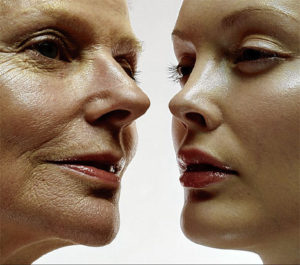The Mummification of Modern Life in the Age of Hyperpast

“We wish to use history only insofar as it serves living” says Friedrich Nietzsche in his famous essay on ‘The Use and Abuse of History for Life’. Nietzsche wants us to look in the rear mirror only in order to understand the present by considering previous process and to desire the future more keenly. History, according to Nietzsche, should be a spiritual value for life. This great anti-modernist was lucky enough not being able to imagine a world in which the past would be in use as a toy for leisure, amusement and escape from reality.
The enormous popularity of things from the past
We live in the beginning of the 21 century, but nothing is nowadays as popular as things from the last century and from the days before the last century. Moreover, one can’t overlook the strange fact that things from the past have become the “scenery” for the world of today. Things from the past are everywhere out there, and more and more from the past is added on a daily basis to a supposedly modern time. Many European towns and villages, for instance, look exactly again as in the middle ages, or in the days when overland trips where done with horse coaches.

Restaurants and coffee shops in restored historic city centers offer an atmosphere of overwhelming rusticity. On Swiss lakes one can enjoy the view to the alps from restored steam boats, and more and more restored steam engines link more and more romantic spots in touristic areas. Needless to say that the luxurious wagons of the legendary ‘Orient Express’ are rolling again between Paris and Venice. Soon, rich people will be able to cross the Atlantic in a real fashionable manner; as an international consortium is rebuilding the ‘Titanic’ in its original shape.

Countless bands from the sixties and the seventies celebrate their revivals with pompous appearances. In Hamburg, the old ‘Star Club’ has opened again; the place where the ‘Beatles’ started their career five decades ago. Paul McCartney, the ex Beatle with his preposterous eternal boyishness, was guest of honor at the opening. To a seemingly touched audience he expressed his pleasure to be finally back again where everything started. Also, the once upon a time first American orbiting earth, John Glenn, was recently back again on his stage; in space.
There is almost nothing from the recent past which not successfully has been recycled for the world of today. Such things as the legendary VW Beetle, the Mini Cooper, or the Fiat 500: the iconic Italian city car, are nothing but tiny little drops in a never ending tsunami of so called retro design.






There is nothing much wrong with it from an aesthetic point of view, but anything really new in architecture, design, fashion or music is surprisingly hard to find. “Out with the new, and in with the old” is trendy and, of course, the most trendy things in that respect are antiques. An antique, by definition, is an old, valuable object with historic or cultural significance. It can be a piece of furniture, an everyday household item, or a work of art. Traditionally, silverware, toys, lamps, and vintage clothes were always among the most sought-after objects. But nowadays literally speaking everything from the past is collected in a desperate manner. Recipe booklets, old Christmas kitsch, comic magazines, bisquit tins, old cards, vintage evening bags, picture frames, old aprons, teddy bears, vinyl records, and even yesterday papers have become hot collector items.

We tend to assume that fondness for old things is a matter of nostalgia; that it is natural to preserve old things in order to look back with sentimentality and love to periods of time where we were. Also, one could believe that the popularity of objects from the past is a sign for a common emotional resistance to all these heartless, cold, impersonal achievements in contemporary science and technology. Therefore, it seems as if people simply prefer heartwarming flea market junk than the kind of contemporary junk exhibited in IKEA stores.There is, however, a completely different reason for the past as the setting for contemporary everyday life.
The resurrection of the past as hyperpast
The Oxford English Dictionary defines reality as “the quality of being real or having an actual existence.” Such conventional definitions don’t reflect the importance of media and culture as pillars of contemporary reality. The postmodern social theorist Jean Baudrillard argued that media and consumer culture had gone into overdrive and let to a sort of ‘Matrix-style’ scenario where there’s no originality left and what seems real is just a simulation. According to Baudrillard, we’ve become so bombarded with images that we’ve lost touch with reality, and, what’s more, mistake these images, or “simulacra”, for reality in itself. The logical result is that events and things may seem real, but it’s no longer really real, but “hyperreal”.
Hyperreality, as Baudrillard labels it, is seen as a condition in which what is real and what is fiction are blended together so that there is no longer a clear distinction between where one ends and the other begins. Significantly, President Trump doesn’t know the difference between reality and fiction. He obviously doesn’t even know that such a difference exists. It is in the nature of the sake that hyperreality has created a societal situation where facts in the real existing world appear as manipulations, or “fake news”, aimed to undermine the supposedly “truth” of a fictitious reality.
The twin to this postmodern hyperreality is something one could describe as hyperpast. We are so bombarded with all kind of things from the past, that the never ending resurrection of the past, has become a setting for contemporary everyday life, and is confused with the past in itself. This means that the past does not belong any longer to a different period of time. There is absolutely no difference anymore between the past in itself and resurrections of consumable phenomena from the past. This whole thing has a truly metaphysical dimension; nothing from the past has disappeared, everything is still around. Traditionally, only objects exhibited in museums have an eternal life. It seems, however, as if the entire world has become integrated into the traditional concept of the museum.

And what is valid with regard to old-timer cars, steam engines, and teddy bears applies to human beings as well. Therefore, I would like to show in the following that the obsession with things from the past is closely interrelated with the “Forever Young!” movement.
Forever-Young as Hyperpast-Zeitgeist
Let’s start with the undeniable fact that it is not only a social stigma to be old, but also an aesthetic taboo. If one is old and poorly dressed one is not supposed to be seen anymore. Ideal human beings are young, good looking, well dressed, healthy and wealthy. From a certain age on, around fifty or so at the latest, one is expected to look at least twenty years younger. Only eccentric millionaires and homeless people can afford to have as many wrinkles in their faces as Keith Richards from the ‘Rolling Stones’.

The industry offers a variety of methods and techniques aimed to change in an artificial way the natural direction of our body towards old age. “Forever Young!” has become the most powerful societal imperative. In advertising campaigns for ant-aging methods it is triumphantly insinuated that lying about one’s age has become very easy. But the products themselves are presented to consumers in a linguistic form of harsh commands; Start turning back the clock now! Slow down aging! Look and feel half your age! Get a gorgeous skin! Get familiar with new no-knife neck lifts! And, indeed, it is a social standard to follow these commands. People spend enthusiastically big amounts of money in order to look as young as possible. Even relatively young individuals in their twenties have become crazy for facial fillers. The result is in most cases simultaneously terrible and ridiculous. But people prefer nevertheless to look like techno-humans or extra terrestrial beauties like Kim Kardashian.

“Better with no shadow on the face than to look even slightly aged” is the dictate of the moment.

The idea that death is our natural exit from the here and now is not mentioned anymore. Death, however, is surely not so much a threat but rather a relief in case one has managed to do something meaningful in life. Most people, however, strongly feel that their life was meaningless. And indeed, a life that contained nothing but some love affairs, two or three marriages, job related problems, TV watching, vacations, debts, illnesses etc., must necessarily appear from a certain point on as a disgrace.
But, unfortunately, that’s in the nature of the societal sake. The 20th century with its two world wars was the age of physical extinction, and the 21th century is characterized by a systematic elimination of meaning. The psychological implications are terrible. When I realize one day that my entire life was wasted in an endless orgy of meaningless activities, than the outlook towards my natural end can’t be anything else than an unbearable cynicism. And that’s exactly the reason why the aged and dying body does not exist anymore. Death has completely disappeared from the general public. The many times long and painful process of dying takes place in societal institutions hidden away from the public.
What a terrible dilemma! Walking on the way towards the natural exit of life appears under the given circumstances as absolutely unacceptable, and a time machine back to one’s youth is not available.

There’s only one solution to this dilemma; I have to find a satisfying meaning in my life despite the fact that I start to look old. Reading good books or listening to classical music can’t be a solution. That wouldn’t improve my existential situation. Therefore, the only acceptable meaning I can adjust to my meaningless life in my aged body is to look as young as possible.
Having done all I could do to look “young” gives me mercifully the idiotic illusion that the world out there is still a fascinating challenge. But that’s not all. The artificial reconditioning of my youthful past, expressed in my fashionable costumes of youth, health, and vitality goes hand in hand with a particular taste.

Taste is the way we make contact with the world. Visiting flea markets and auctions for collectibles is a particular way of getting in contact with the world. Alert observers can’t look away from the fact that the audience of such events are in their majority faithful followers of the “Forever Young” movement. The explanation for this is close at hands. Anti-aging methods are popular because they offer an escape from the laws of existence, and so do all kind of antiques. Flea market junk and antiques can give us the feeling to experience a period of time here and now in which we have not yet approached the “thereness” in which we actually exist. Consequently, antiques and anti aging methods are just two sides of the same coin; instruments for the mummification of meaninglessness in the age of hyperpast.


